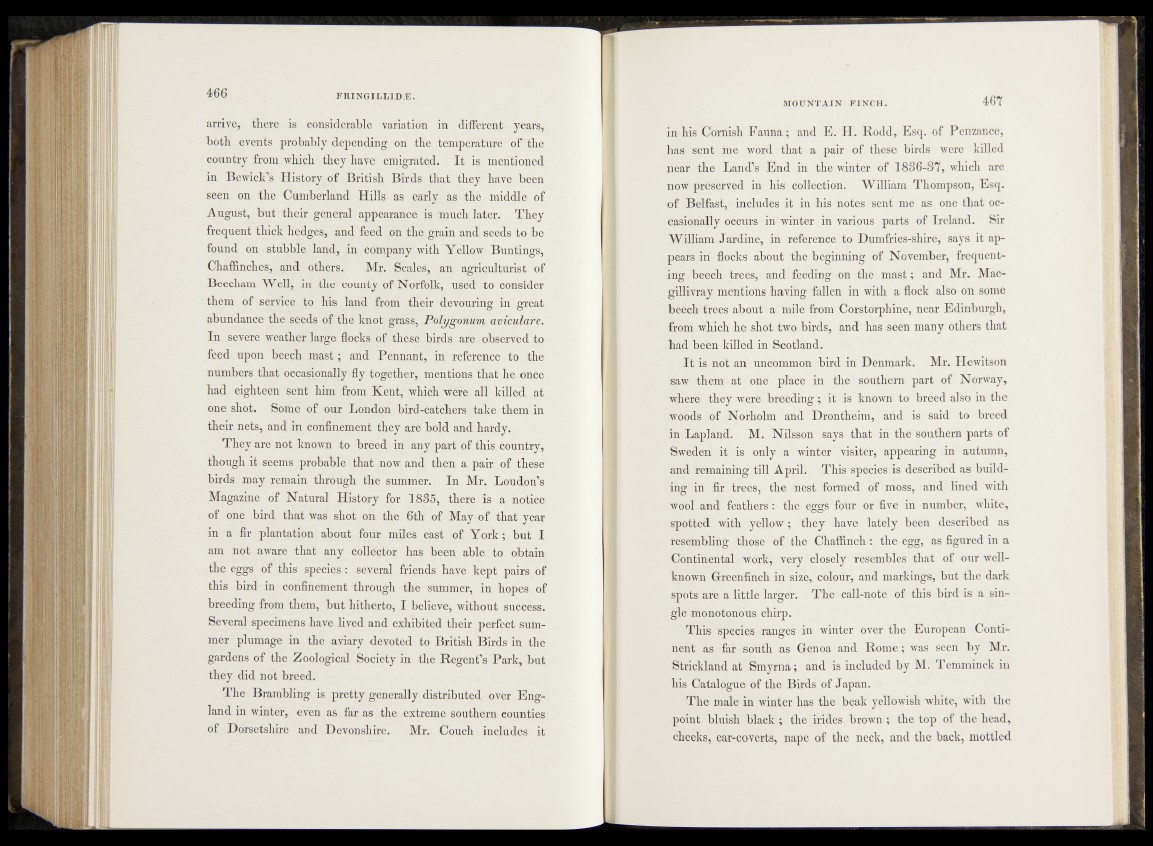
arrive, there is considerable variation in different years,
both events probably depending on the temperature of the
country from which they have emigrated. It is mentioned
in Bewick’s History of British Birds that they have been
seen on the Cumberland Hills as early as the middle of
August, but their general appearance is much later. They
frequent thick hedges, and feed on the grain and seeds to be
found on stubble land, in company with Yellow Buntings,
Chaffinches, and others. Mr. Scales, an agriculturist of
Beecham Well, in the county of Norfolk, used to consider
them of service to his land from their devouring in great
abundance the seeds of the knot grass, Polygonum aviculare.
In severe weather large flocks of these birds are observed to
feed upon beech mast; and Pennant, in reference to the
numbers that occasionally fly together, mentions that he once
had eighteen sent him from Kent, which were all killed at
one shot. Some of our London bird-catchers take them in
their nets, and in confinement they are bold and hardy.
They are not known to breed in any part of this country,
though it seems probable that now and then a pair of these
birds may remain through the summer. In Mr. Loudon’s
Magazine of Natural History for 1835, there is a notice
of one bird that was shot on the 6th of May of that year
in a fir plantation about four miles east of York; but I
am not aware that any collector has been able to obtain
the eggs of this species : several friends have kept pairs of
this bird in confinement through the summer, in hopes of
breeding from them, but hitherto, I believe, without success.
Several specimens have lived and exhibited their perfect summer
plumage in the aviary devoted to British Birds in the
gardens of the Zoological Society in the Regent’s Park, but
they did not breed.
The Brambling is pretty generally distributed over England
in winter, even as far as the extreme southern counties
of Dorsetshire and Devonshire. Mr. Couch includes it
in his Cornish Fauna; and E. H. Rodd, Esq. of Penzance,
has sent me word that a pair of these birds were killed
near the Land’s End in the winter of 1836-37, which are
now preserved in his collection. William Thompson, Esq.
of Belfast, includes it in his notes sent me as one that occasionally
occurs in winter in various parts of Ireland. Sir
William Jardine, in reference to Dumfries-shire, says it appears
in flocks about the beginning of November, frequenting
beech trees, and feeding on the mast; and Mr. Mac-
gillivray mentions having fallen in with a flock also on some
beech trees about a mile from Corstorphine, near Edinburgh,
from which he shot two birds, and has seen many others that
had been killed in Scotland.
I t is not an uncommon bird in Denmark. Mr. Hewitson
saw them at one place in the southern part of Norway,
where they were breeding; it is known to breed also in the
woods of Norholm and Drontheim, and is said to breed
in Lapland. M. Nilsson says that in the southern parts of
Sweden it is only a winter visiter, appearing in autumn,
and remaining till April. This species is described as building
in fir trees, the nest formed of moss, and lined with
wool and feathers : the eggs four or five in number, white,
spotted with yellow; they have lately been described as
resembling those of the Chaffinch : the egg, as figured in a
Continental work, very closely resembles that of our well-
known Greenfinch in size, colour, and markings, but the dark
spots are a little larger. The call-note of this bird is a single
monotonous chirp.
This species ranges in winter over the European Continent
as far south as Genoa and Rome; was seen by Mr.
Strickland at Smyrna; and is included by M. Temminck in
his Catalogue of the Birds of Japan.
The male in winter has the beak yellowish white, with the
point bluish black ; the irides brown ; the top of the head,
cheeks, ear-coverts, nape of the neck, and the back, mottled